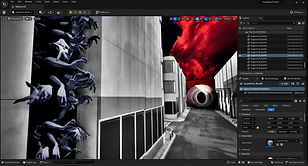Nightmare Doctor
Platform:
Windows PC
Engine:
Unreal Engine
Language:
UE5 blueprint
Tools Used:
Unreal Development Kit, Photoshop, SunoAI
Duration:
10 weeks
Completion:
2024
Team Size:
1
Role:
Concept, prop and texture placement, lighting, blueprint scripting, all gameplay scripting.
Game Trailer
Gameplay Showcase
Download Nightmare Doctor
Introduction
According to my Final Major Project game “Nightmare Doctor” is a first-person psychological horror game developed and produced using Unreal Engine 5. The game design is inspired by several games such as ENDLOOP, The Bridge Curse 2, Portal, and Pools.
ENDLOOP and Pools are Walking Simulation psychological horror games that utilize thematically appropriate scenery and sound effects to make the game feel more immersive. The Bridge Curse 2, a horror game from a Taiwanese developer, is worth exploring for me because of its smooth and evocative plot. Then there's Portal a gameplay mechanic of traveling from one portal to another, which I took advantage of and added to my game project.
The aim of Nightmare Doctor is not just to make another horror game, but to explore the psychological and emotional responses of the player in the face of subconscious fears and challenges. By integrating detailed dream horror elements, advanced AI behaviors and an engaging narrative, the game aims to provide players with an immersive and emotional experience. The project also aims to reflect current trends in the gaming industry where psychological horror and emotional interactions are becoming increasingly popular themes.
Story Concept
The game is set in a semi-future city where technology has advanced to the point where human dreams can be explored and manipulated. The main character is a dream interpreter who has the special ability to enter the dreams of others and help them solve their psychological disorders. This technique was originally used to treat serious mental illnesses, but with the popularity of the technology, more and more people are seeking help to deal with the psychological pressures of daily life.
Setting and World
The game takes place in 2030, and many civilians struggle in their own nightmares while sleeping. We call those civilians patients. As a dream interpreter, the protagonist will enter the patient's dream to solve their obstacles. The environments range from spooky and decaying scenes to abstract, surreal landscapes.
Application of Academic Theories in Development


Uncanny Valley and AI Behavior Models
During the development of Nightmare Doctor, I drew heavily on academic theories surrounding the uncanny valley effect and AI behavior, as discussed in the literature ‘What Design Choices are Effective in Inducing Fear and Tension in First-Person PC Horror Games?’ discussed in. The research highlights the importance of enemy AI and movement patterns in creating feelings of tension and fear. I applied these theories by designing enemies that exhibited an uncanny valley appearance and combining them with wrap-around behaviors to evoke feelings of fear and discomfort in the player.
The AI logic in Doctor Nightmare focuses on two main behaviors: chasing and outflanking, which are essential elements of horror games. This approach is inspired by classic games such as Pac-Man, which create tension through simple but effective AI mechanics. By implementing these AI behaviors, the game creates an environment where the player constantly feels chased and threatened, thus enhancing the sense of psychological terror.
In this level I had the AI use the Weeping Angle mechanic, where the player's line of sight can't be taken away from them, and once it is they walk towards the player. This allows for a more interactive gameplay and also creates a sense of psychological terror.
Visual and Audio Orchestration

Another key area of development was the coordination of visual and auditory elements to evoke tension and fear. This idea was influenced by the book The Effects of Vision and Sound on Physical Arousal and Tension in Horror Games, which emphasizes the importance of sound in creating tension. In Nightmare Doctor, sound design plays a crucial role in making the player feel uneasy. Ambient sounds, sudden noises and eerie music are used to create a constant sense of unease, even when there is no immediate visual threat.
Visually, the game employs dark, dreamlike environments that distort reality and further intensify the psychological horror. The use of AI-generated visual assets helps to achieve a coherent and disturbing aesthetic that complements the audio design and fully immerses the player in the nightmarish world.
Emotion and Player Interaction
The emotional impact of the game was another focus of the development process. I drew on research about the role of emotion in the horror experience when designing Nightmare Doctor to engage the player on a psychological level. The game's narrative and decision-making mechanics are designed to evoke fear, anxiety and introspection in the player. By forcing the player to face their fears and make difficult choices, the game stimulates a strong emotional response, creating a deeply immersive experience that goes beyond traditional gameplay.
The emotional impact of the game was another focus of the development process. I drew on research about the role of emotion in the horror experience when designing Nightmare Doctor to engage the player on a psychological level. The game's narrative and decision-making mechanics are designed to evoke fear, anxiety and introspection in the player. By forcing the player to face their fears and make difficult choices, the game stimulates a strong emotional response, creating a deeply immersive experience that goes beyond traditional gameplay.
AI Technology in Game Development

Artificial Intelligence technology played an important role in the development of Nightmare Doctor, especially in the audio, music and visual design of the game. By using AI tools, I was able to streamline the creative process and achieve high-quality effects that enhance the overall atmosphere and immersion of the game.
AI in Audio Design
Usually it's downloaded from copyright free audio sites such as Pixabay, Freesound, ncs, etc. So for this game I used Suno AI to complete my music in the game.
In Suno AI I can type in the style I want, the direction, the melody these keywords and so on and it will produce it!
So in terms of audio design, AI is used to generate various sound effects and background music. The AI-assisted sound design allows for the production of eerie, tension-building sound effects that complement the game's psychological horror theme. These AI-generated sounds were then fine-tuned and integrated into the game to ensure that they were consistent with the visual and narrative elements to create a coherent and disturbing atmosphere.



AI in Visual Design
Artificial Intelligence also played a crucial role in the visual design of Nightmare Doctor. I utilized AI tools to assist in generating textures, environments and other visual assets. This approach not only saved time, but also created unique and detailed environments that contributed to the game's surreal and dreamlike aesthetic. Using AI in the visual design allowed me to experiment with different styles and effects, which ultimately enhanced the overall visual impact of the game.
For the visual design I used Photoshop, Lexica, Dall-E as AI tools to create the graphic design and UIUX to be added to the game.
Incorporating AI technology into the development process had a significant impact on the overall efficiency and creativity of the project. By automating certain aspects of the design, I was able to focus more on refining game mechanics and narrative elements. The use of AI also gave me more flexibility to experiment with different ideas and concepts, resulting in a more polished and immersive final product.





























